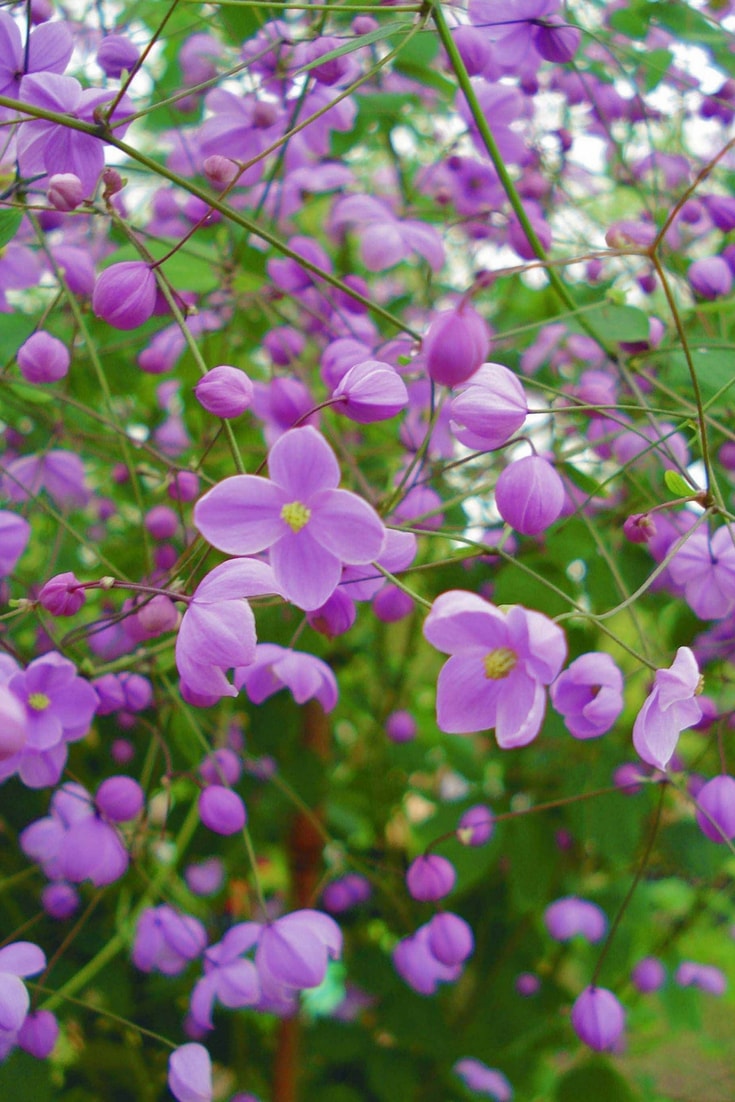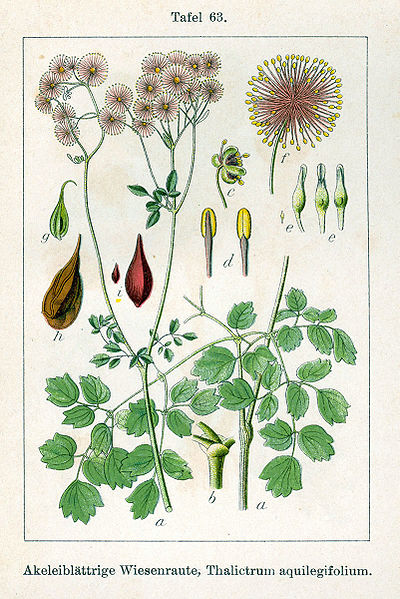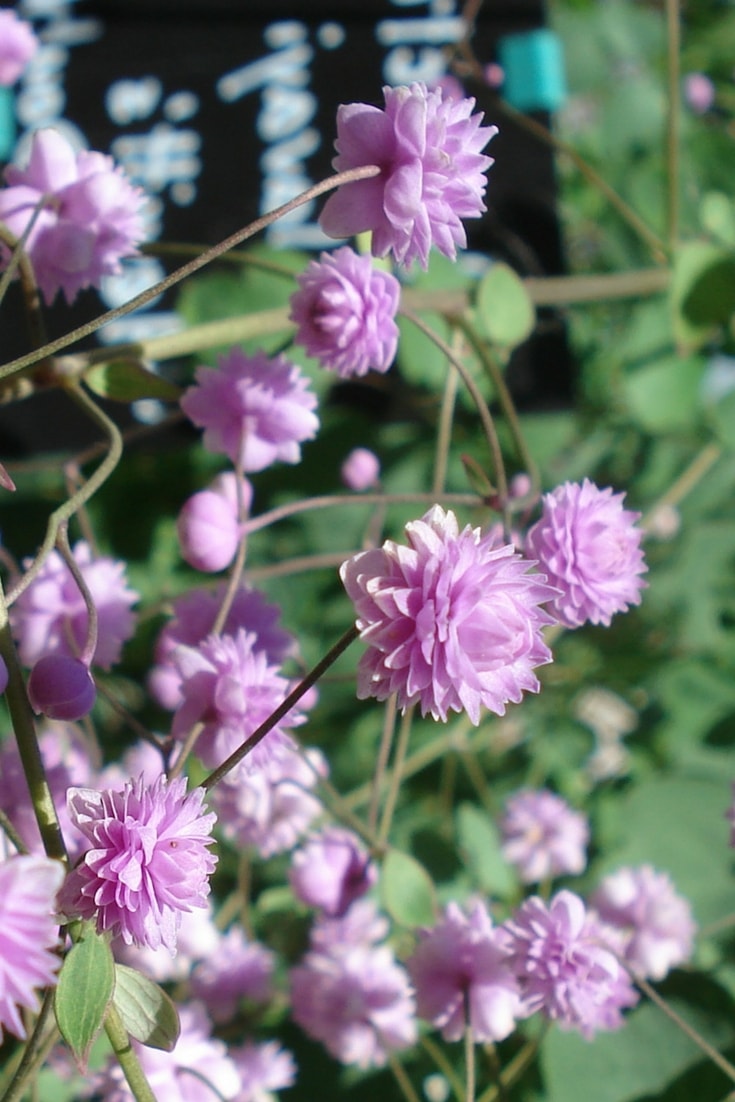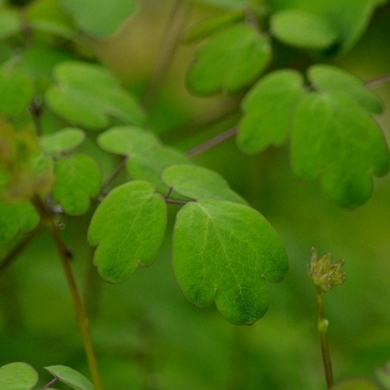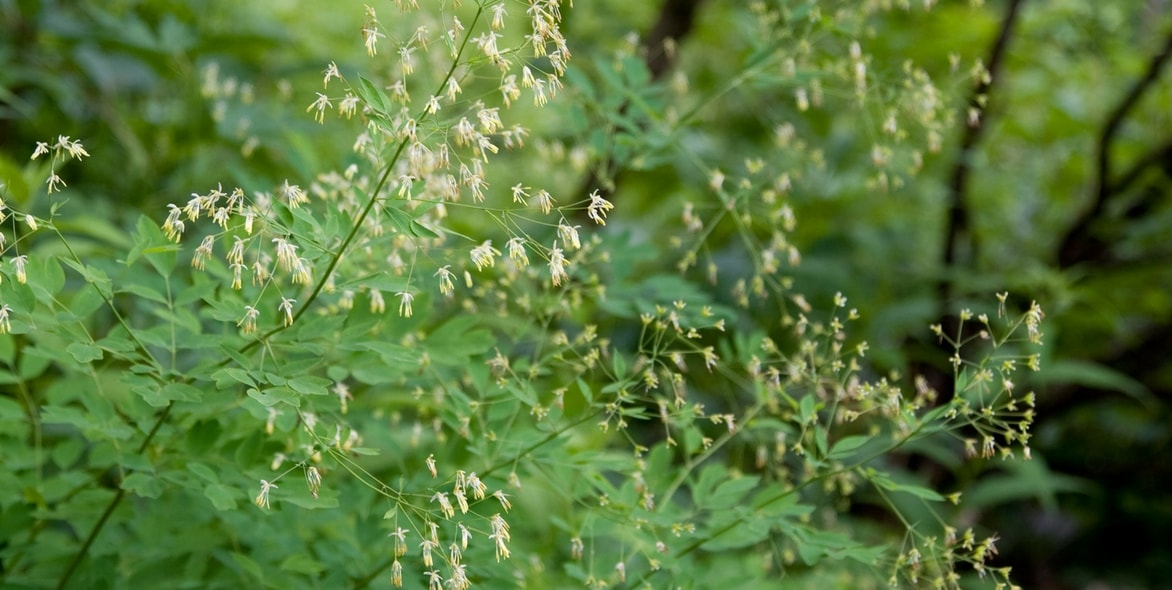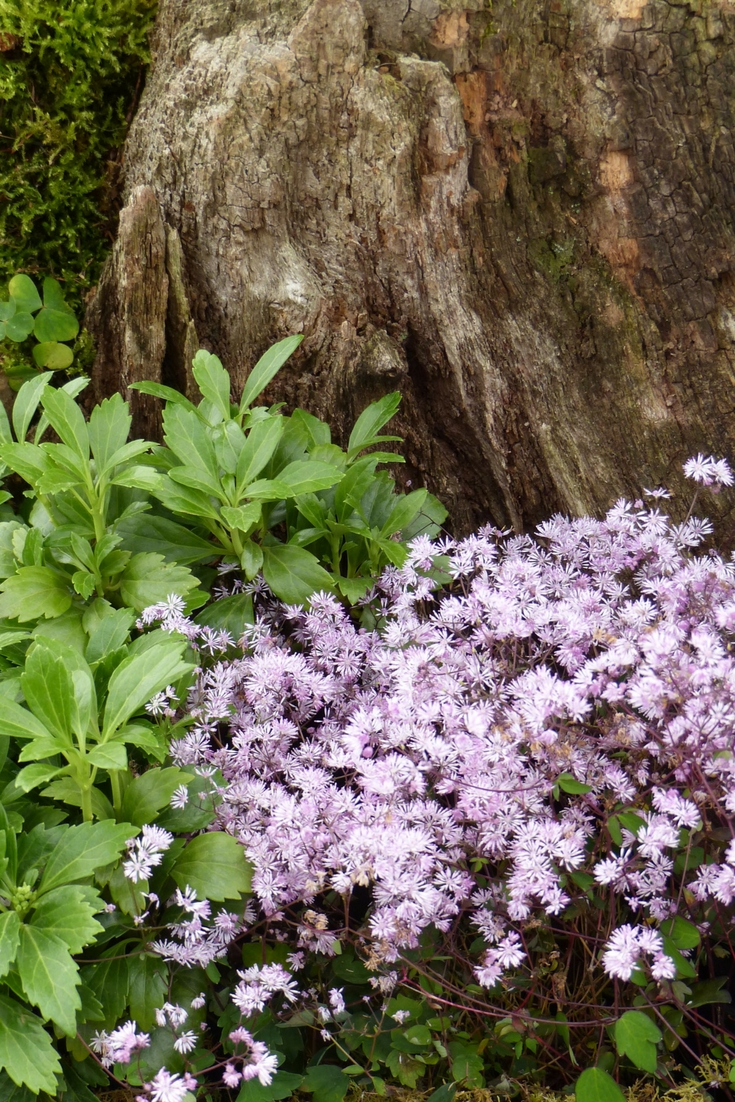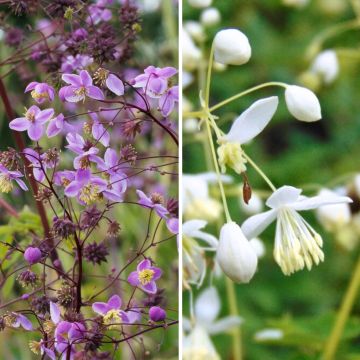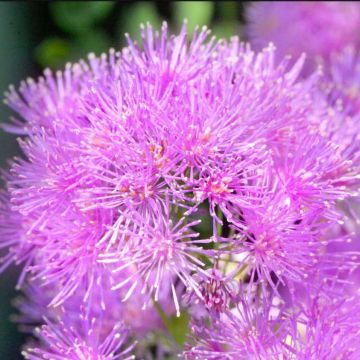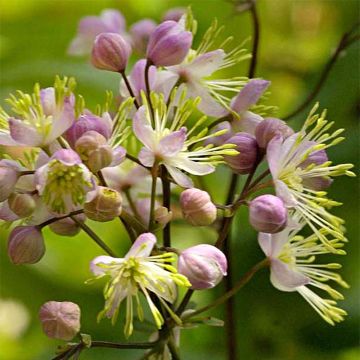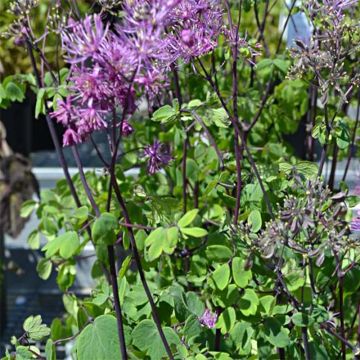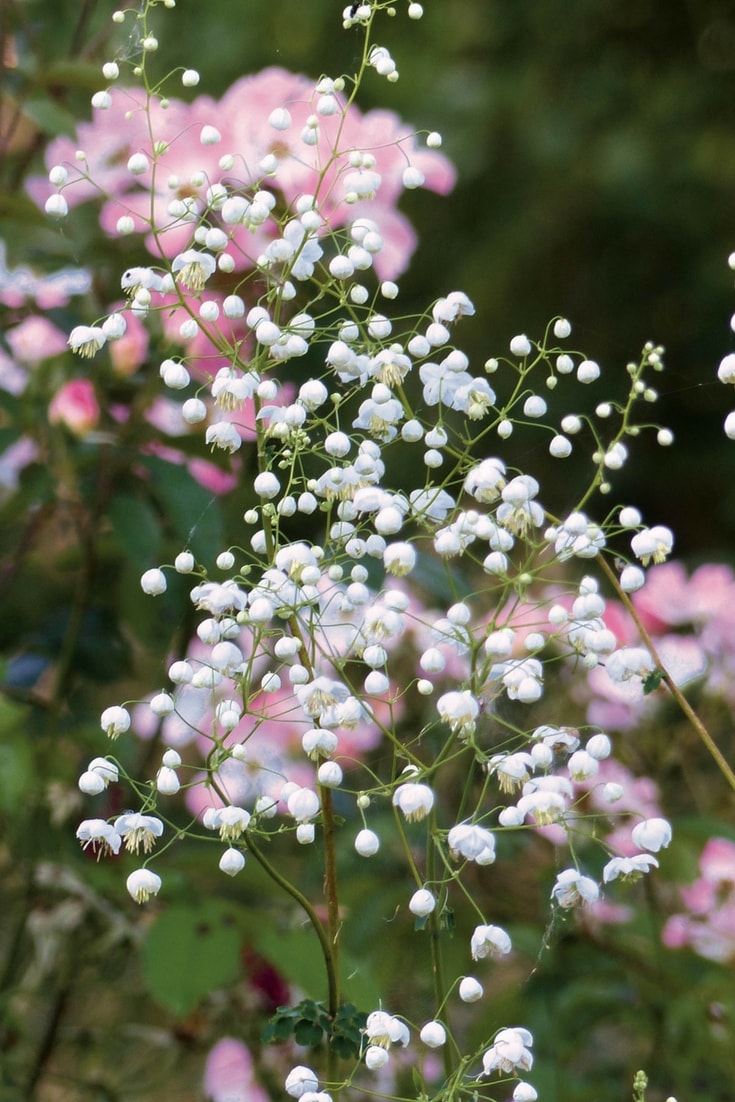
Thalictrum, Meadow Rue: Planting, Cultivation and Companion Planting
Contents
How to plant, grow and combine thalictrum in the garden
- Floriferous and spectacular, this is a substantial yet graceful perennial with the appearance of a giant baby’s breath
- Its opulent, airy blooms in pink, lilac, yellow or white brighten shady corners in spring and especially during summer
- It boasts lush, finely-cut foliage in soft green or glaucous tones, reminiscent of columbine leaves
- Fully hardy and long-lived once established in rich, moist soil, it requires very little maintenance
- A hallmark of cottage gardens and English mixed borders, it’s our favourite perennial for naturalistic planting schemes!
Our expert's word
Known as Meadow Rue or Columbine Meadow Rue, the Thalictrum is a floriferous perennial with delicate, finely divided foliage in soft green or bluish-grey, remarkable for the poetry and abundance of its flowering.
Its airy, ethereal inflorescences, which reach over two metres tall for some beautiful cultivars like the Thalictrum delavayi ‘Splendide’, light up shady areas of the garden. Resembling tousled starry clouds, its tiny flowers form, from May-June to September depending on the variety, a mist of lilac, pink, white, or yellow. The Thalictrum delavayi, the most iconic of Meadow Rues, and the Thalictrum aquilegifolium, are two remarkably floriferous species.
From towering specimens like the Thalictrum ‘Elin‘ to ground-covering species like the Thalictrum kiushianum, Meadow Rue suits all garden styles. The giants of the genus will play the dazzling role of mid-border or back-of-border plants, creating an evanescent mist. The diminutive species will form mossy flowering carpets for cool rockeries and walls.
Its tall, feathery silhouettes, highly prized in England, are classic choices for natural, informal gardens, adding a poetic and expressive touch to cottage gardens and mixed borders.
It is a staple of pink gardens, lending them nuance, lightness, and transparency. Thalictrum is the ideal companion for old roses, with which it creates opulent and romantic spring and summer scenes.
Well-established under deciduous trees, in rich, moist but well-drained soil, and sheltered from wind, Meadow Rue forms generous clumps in just a few years alongside Japanese Anemones, Bleeding Hearts, Astilbes, Masterworts, Lilies, Foxgloves, or Hardy Geraniums. It creates a pleasing contrast when paired with less flexible plants like Hostas or Ferns.
When cut, its light floral stems make very pretty fresh or dried bouquets with a rustic charm.
Romantic, airy, spectacular—discover Thalictrum, this easy-going, floriferous perennial that brightens the garden!
Botany
Botanical data
- Latin name Thalictrum
- Family Ranunculaceae
- Common name Meadow Rue, Delavay's Meadow Rue, Columbine Meadow Rue
- Flowering May, June to July
- Height from 10 cm for dwarf species to over 2.50 m for the tallest
- Exposure partial shade, shade
- Soil type neutral to acidic (ericaceous)
- Hardiness -15°C
Thalictrum, also called Meadow Rue, is a herbaceous perennial plant from the same family as buttercups: the Ranunculaceae. Native to cool, humid mountainous areas, it is most commonly found in temperate regions of the Northern Hemisphere, in America, Europe and Asia, mainly in China and Japan. In the wild, it grows at high altitudes, in cool, shaded areas, by streams, in forests, meadows and grassy slopes.
Vigorous, Meadow Rue can be planted throughout France, except in very windy regions and Mediterranean climates. Most have a clear preference for regions with cool, humid summers. The apparent lightness and delicacy of Thalictrum is deceptive: it is a sturdy perennial with robust health. Perfectly hardy, Meadow Rue resists frost and can tolerate temperatures as low as -15°C, but only for short periods.
In Greek, Thalictrum means “that greens quickly”, referring to its tendency to develop abundant foliage very rapidly.
This genus comprises over 130 species of rhizomatous or tuberous perennials. From towering specimens to ground-covering species, every Thalictrum finds its place in the garden. The main species cultivated in our latitudes are: Thalictrum delavayi, the most emblematic of the Meadow Rues, and Thalictrum aquilegifolium, two remarkably floriferous species. Some hybrids, like Thalictrum ‘Elin’, are giants that can reach nearly 3 metres in height. Among the most commonly cultivated species, Thalictrum rochebrunianum is one of the most imposing. Thalictrum actaeifolium and Thalictum flavum have the particularity of bearing fragrant flowers, not to mention the adorable ground covers like Thalictrum kiushianum, which doesn’t exceed 10 cm in height.
Tall Thalictrums have an upright, airy habit forming vigorous, spreading clumps that can reach 60 cm in width. They are perfect planted in semi-shaded borders, woodland areas or prairie gardens. The smaller varieties make excellent plants for cool rockeries.
Somewhat slow to establish, Meadow Rue needs about two years to fill out and reach its full potential. But it’s worth the wait, as it becomes more beautiful with each passing year. Once well-rooted, this rhizomatous perennial grows quickly to form dense clumps. Nearly indestructible, it has excellent longevity.
In April, from its robust base emerge, slowly at first, finely divided leaves and tall, slender yet sturdy stems, more or less grooved, highly branched, with a bluish-green or purplish-brown to almost black hue depending on the variety.
As soon as temperatures warm, it quickly forms, in just a few weeks, a large, light and floriferous mass composed of a cloud of tiny flowers.
Spectacular, the feathery flowering gives this tall perennial the appearance of a giant baby’s breath. From June to mid-September, flexible, very airy flower stems, which can reach up to 2.50 m tall for Thalictrum ‘Elin’, bear large panicles or loose corymbs, highly branched with countless fluffy balls that open into small star-shaped flowers (1 to 3 cm). Pink, yellow, lilac, pure white or deep violet, they seem suspended in the air, like arachnid constellations, attached to their very fine peduncles. Petal-less, each flower has simple or semi-double sepals surrounding clusters of stamens, sometimes so prominent that they give the flowers the appearance of frothy pompons reminiscent of baby’s breath or mimosa.
The flowers are sometimes bicoloured with white or pink sepals and contrasting purplish stamens, lilac with white tips, white touched with green or yellow. The sepals fall more or less quickly at the start of flowering, leaving the clouds of star-like stamens to provide the colour. Some cultivars like Thalictrum delavayi ‘Hewitt’s Double’ have no stamens but double flowers, resembling tiny, soft and velvety roses.
Flowering lasts a good month. While Thalictrum delavayi flowers from summer until late autumn, Thalictrum aquilegifolium offers spring flowering in May-June.
Fragrance isn’t the main asset of Thalictrum flowers, however, some species like Thalictrum flavum and Thalictrum actaeifolium are fragrant, emitting a light bergamot scent. Particularly attractive to pollinators, they draw in pollinating insects.
Each pollinated flower produces a small winged fruit. When planted in favourable conditions, in heavy, moist soil, Thalictrum (notably T. aquilegifolium) tends to naturalise by self-seeding. Once mature, the brown seeds are dispersed by the wind.
The cloud-like inflorescences of Meadow Rue make lovely airy bouquets both fresh and dried: in a vase, the flowers last a good week after picking. They are perfect in rustic, romantic bouquets, paired with roses, lilies or umbellifers.
The foliage, of rare elegance, is as interesting as the flowering. Deciduous, it disappears in winter and only reappears late in spring, allowing Thalictrum to be paired with bulbous plants that occupy the space early in the season. Finely cut and light, it resembles that of certain ferns like maidenhair fern, but even more so that of columbines: a resemblance that earned Thalictrum aquilegifolium the nickname “Columbine Meadow Rue”. Very fine and delicate in appearance, the serrated leaves, divided into rounded, flat leaflets with 3 to 5 lobes, measure from 10 to 40 cm depending on the species. As they spread, they add a certain opulence to the plant. The foliage displays beautiful shades of green, from lime to glaucous with a slightly bluish and silvery hue.
While resembling Baby’s Breath, Thalictrum prefers the cool atmospheres of woodland edges; it likes bright exposures but without direct sun during the hottest hours. It’s best given a spot with morning or evening sun, under the canopy of deciduous trees. Conversely, Thalictrum doesn’t like overly dense shade which would limit its flowering: avoid planting it in competition with shrubs that might deprive it of light and create overly dry soil in summer. It’s better to give it a place sheltered from dry, strong winds that could dry out the foliage and flatten the tall flower stems.
Very easy to grow and low-maintenance, it does require, for good flowering, soil rich in organic matter, well-drained and free of lime. While tolerant of most soil types (except very poor, dry and stony soils), it typically prefers woodland soil, neutral or acidic. It likes light soils, even heavy ones, as long as they remain moist and sufficiently damp with good mulch during the growing season. Moist soil allows it to develop vigorously.
The towering specimens like Thalictrum ‘Elin’ are rarely used as standalone plants but are planted at the back of borders, paired with other large-growing perennials or shrubs that will act as supports, preventing their clumps from flopping unattractively. The ground-covering species, like Thalictrum kiushianum, are reserved for cool rockeries and flowering walls.
The specific name delavayi was given to Thalictrum in honour of Father Jean-Marie Delavay, a Christian missionary who, in the 19th century, collected one of the largest botanical collections in China for the National Museum of Natural History in Paris.
Main species and varieties
The Thalictrum genus includes around 130 species of varying sizes and flower colours. From dwarf Thalictrum to giant Meadow Rues, each finds its place in the garden. Thalictrum delavayi is the most iconic of the Meadow Rues, and along with Thalictrum aquilegifolium, it ranks among the most floriferous in the genus. Both feature many interesting cultivars. Among the most commonly cultivated species, Thalictrum rochebrunianum is one of the most imposing. While most Meadow Rues are unscented, some emit a light fragrance. Tall Thalictrum make excellent mid-border or background plants for semi-shaded areas, while dwarf varieties like Thalictrum kiushianum are perfect for cool rockeries, slowly forming a charming, floriferous little carpet.
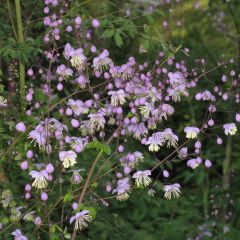
Thalictrum delavayi - Meadow-rue
- Flowering time July to September
- Height at maturity 1,70 m
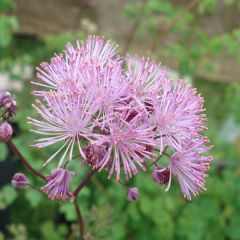
Thalictrum aquilegiifolium - Meadow-rue
- Flowering time July, August
- Height at maturity 1,20 m
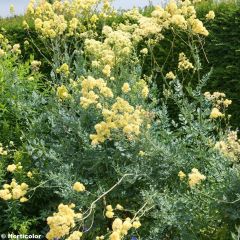
Thalictrum flavum subsp. glaucum - Meadow-rue
- Flowering time July, August
- Height at maturity 1 m
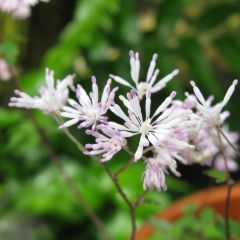
Thalictrum kiusianum - Meadow-rue
- Flowering time May to October
- Height at maturity 15 cm
Giant Meadow Rues:
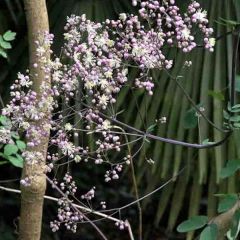
Thalictrum Elin - Meadow-rue
- Flowering time July, August
- Height at maturity 2,50 m
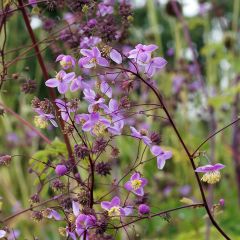
Thalictrum delavayi Splendide - Meadow-rue
- Flowering time August, September
- Height at maturity 1,75 m

Thalictrum delavayi Splendide Album - Meadow-rue
- Flowering time August, September
- Height at maturity 1,50 m
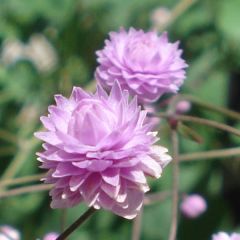
Thalictrum delavayi Hewitts double - Meadow-rue
- Flowering time July to October
- Height at maturity 1 m
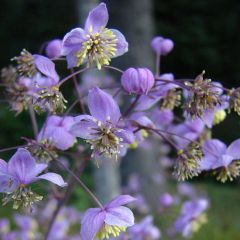
Thalictrum rochebrunianum - Meadow-rue
- Flowering time August, September
- Height at maturity 1,50 m
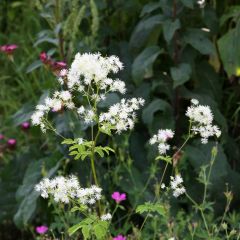
Thalictrum aquilegifolium Album - Meadow-rue
- Flowering time July, August
- Height at maturity 1,20 m
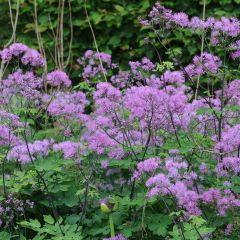
Thalictrum Black Stockings - Meadow-rue
- Flowering time July, August
- Height at maturity 1 m
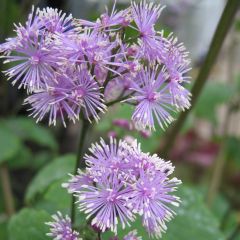
Thalictrum actaeifolium Perfume Star - Meadow-rue
- Flowering time July, August
- Height at maturity 80 cm
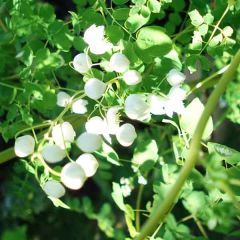
Thalictrum delavayi Album - Meadow-rue
- Flowering time August, September
- Height at maturity 1,50 m

Thalictrum delavayi Splendide - Meadow-rue
- Flowering time August, September
- Height at maturity 1,75 m

Thalictrum Elin - Meadow-rue
- Flowering time July, August
- Height at maturity 2,50 m

Thalictrum delavayi Splendide Album - Meadow-rue
- Flowering time August, September
- Height at maturity 1,50 m
Discover other Thalictrum - Meadow Rue
Planting and maintenance
When to Plant?
Thalictrum can be planted in spring from March to May after the last frosts or in autumn from September to November, once the intense heat has passed.
Where to Plant?
Despite its reputation as an easy-to-grow perennial, Thalictrum has a few requirements: it dislikes hot, drying exposures, dry and strong winds, and root competition.
Vigorous, Thalictrum grows well almost everywhere in France, except in dry and very windy regions and Mediterranean climates, as it fears scorching sun. The Meadow Rue will tolerate summer heat in temperate regions, provided the soil remains consistently moist and cool.
Highly hardy, it withstands frost and can tolerate temperatures as low as -15°C, but only for short periods.
Thalictrum thrives in a partially shaded, open spot, sheltered from strong winds: it will flourish in dappled shade, away from direct sunlight, under deciduous trees, which provide beneficial coolness. It prefers an open position, encouraging it to reach its full height. Dense shade may limit flowering—avoid planting near shrubs that could block its light. It also dislikes root competition, so ensure it has space to breathe!
It has one formidable enemy: wind. An overly exposed location threatens these tall perennials. Their feathery plumes remain graceful only if they stay upright! Choose a spot sheltered from dry, harsh winds that could dry out the foliage and flatten the clumps.
While adaptable to various settings, it truly shines as a mid-border or background plant. The tallest varieties (Thalictrum ‘Elin’, Thalictrum delavayi ‘Splendide’, Thalictrum rochebrunianum) work best at the back of borders, adding ethereal texture and striking height. Planting them on a slope allows full appreciation of their blooms.
Ground-covering species like Thalictrum kiusianum are ideal for shady rockeries or cool flower beds.
How to Plant Thalictrum?
Thalictrum is slow to establish, but once settled after about two years, it becomes very long-lived. The key to growing this robust perennial lies in planting it correctly.
- Soil should be moist to damp but well-drained (waterlogging in winter can be fatal), slightly acidic, and rich in organic matter. It dislikes dry, poor soils where it will never thrive. It prefers medium to light soils kept sufficiently moist with good mulch during the growing season.
- It tolerates slightly clayey soils but struggles in heavy clay. Mix well-rotted compost into the planting hole (5–10 L per plant) before placing the rootball.
- Keep the soil cool around Thalictrum with mulch, especially in summer—this ensures prolonged flowering.
- Once young plants are established, avoid disturbing them. They’ll only begin filling out and flowering properly in their second year.
- If you love Thalictrum’s delicate, lush foliage, so do slugs and snails! Since the foliage dies back in winter, mark the plants with a small stake to monitor spring attacks on new shoots. Fern-based slug repellent helps deter them.
- Plant 2–5 per m², spaced at least 50 cm apart. Thalictrums dislike root competition—avoid planting too close to shrubs. Its airy, translucent structure means group planting creates the best impact in borders.
- For giant varieties, staking is often essential, especially if grown alone. A strong gust could flatten your border! Alternatively, plant them among sturdy companions for natural support.
- A living mulch (e.g., Pachysandra, periwinkle, or bugleweed) helps retain soil moisture.
- Water regularly in the first summer to encourage root development.
Care
Once established in ideal conditions, Thalictrum is low-maintenance. Highly disease-resistant, it requires minimal care, proving to be a trouble-free perennial with ironclad health—provided the soil stays cool and fertile.
- Each winter, spread a thick layer of leaf mulch; as it decomposes, it enriches the soil.
- Fertilise yearly in spring with compost to improve winter drainage and root growth.
- Stake tall varieties if exposed to wind.
- During dry spells, mulch and water thoroughly in the evening. It tolerates summer heat if watered daily.
- Pruning isn’t necessary—just deadhead to prolong blooms and prevent excessive self-seeding.
- In late autumn, cut back spent stems by half.
- Avoid cutting it to the ground in autumn—its foliage reappears in spring, and you might forget its location!
Potential Problems
Meadow Rue’s only known foe is gastropods. Generally trouble-free, it rarely suffers from disease, though powdery mildew may occur in drought. Watch for slug damage on new growth!
Sowing
Dividing the clump is possible but tricky, as there’s a considerable risk of damaging the roots. We don’t recommend it, especially since Thalictrum is very easy to grow from seed.
Indeed, sowing is the simplest method: this perennial is very easy to cultivate from seeds. While some varieties, such as Thalictrum delavayi ‘Hewitt’s Double’ (which is sterile) and hybrids, cannot be propagated by seed, most meadow rues produce seeds that germinate readily. Sow in autumn using fresh seeds from the current year, harvested as soon as they turn brown—before they dry out—or with packet seeds.
- Sow immediately in a cold frame using a mix of compost and garden soil. This cold exposure will encourage germination.
- Plant the seeds 6 mm deep.
- Allow two to three months for germination; they will sprout in spring.
- Transplant once the seedlings are sturdy, when they reach 5 cm in height.
- Protect young plants from slugs when planting out.
Pairing Thalictrum
A reliable choice for lightly shaded borders, the Thalictrum is perfect for brightening up cool areas and playing with subtle shades and gradients. With its tall, airy silhouette, delicate foliage, and pastel inflorescences, it transforms a simple perennial bed into a poetic mixed border. It is the ideal companion for old-fashioned roses, with which it creates opulent and romantic spring and summer scenes. It adds charm to English cottages and dreamy gardens with a rustic or cottage feel, bringing height, exuberance, and lightness. It is a must-have for pink gardens.
It thrives in a community setting, alongside vigorous perennials that will precede or follow its flowering, such as Japanese Anemones, Bleeding Hearts, Aconitum, Columbines, Masterworts, Foxgloves, or hardy Geraniums.
Whether tall or ground-covering, the Thalictrum fits into any setting, and can play the dazzling role of a mid-border or backdrop plant, creating an ethereal mist, or serve as a mossy flowering carpet for cool rockeries.
It creates a delightful contrast when paired with less flexible plants like Hostas or ferns and works wonders with heathland shrubs such as Hydrangeas, with which it forms lush borders.
You can also create beautiful combinations with Lilies, Astilbes, ornamental grasses, or even Uvularia grandiflora. Thalictrums that flower in late summer and early autumn pair beautifully with Asters, complementing their blooms. To keep the base of the Thalictrum cool, consider ground covers like Sweet Woodruff, a carpet of Periwinkles, or soft pink Bugles.
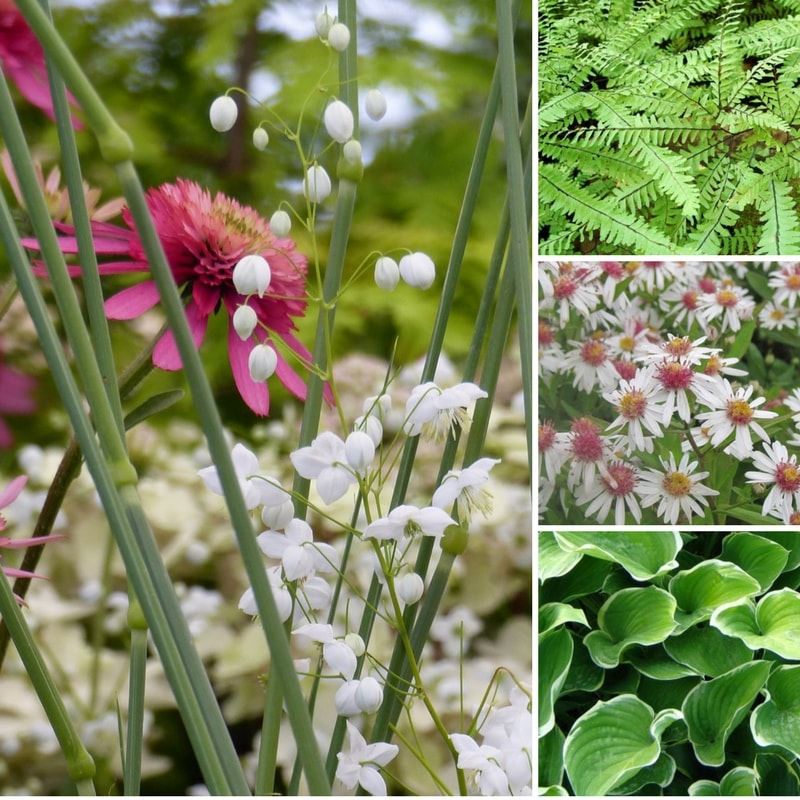

Another example of pairing: Thalictrum delavayi ‘Splendide Album’ with Echinacea ‘Catharina’, Aster lateriflorus ‘Chloe’, Hosta ‘Sagae’, and Adiantum aleuticum ‘Imbricatum’
Need more inspiration? Check out our guide: “Thalictrum, Meadow Rue: 8 Beautiful Pairing Ideas.”
Useful resources
- Collect Meadow Rue seeds! This perennial is one of the easiest to sow!
- Planting perennials properly is easy with our planting guide
- Which plants pair well with Thalictrum? Pierre, our horticultural engineer, shares his valuable advice.
- Also discover our guide on slow-establishing plants
Frequently asked questions
-
Planted two years ago, my Meadow Rue isn't growing, is this normal?
Yes, don't worry. The Meadow Rue needs about two years to establish itself properly and reach its full potential. It may seem sluggish in the first few years. But it's well worth the wait because, as the years go by, it only becomes more beautiful. Once properly rooted, this rhizomatous perennial grows quickly to form dense clumps. Your patience will be rewarded: once well-established, it's practically indestructible!
-
Can Thalictrum be planted as a standalone specimen?
Yes, it's possible but the effect will be less striking than with a group planting. Its beauty truly shines when combined with other perennials. The largest specimens are rarely used alone but are preferably planted in the middle or back of borders, alongside other vigorous perennials like Hostas or Japanese Anemones, or with shrubs such as Hydrangeas which will provide support, preventing their clumps from flopping unattractively.
-
For a shady rockery, which Thalictrum should I choose to add colour?
The Thalictrum genus includes giant specimens as well as lesser-known but remarkably floriferous ground-covering species. Thalictrum kiushianum will be superb in cool rockeries, shaded borders and flowering walls. Over the years, it will form a charming, highly floriferous little carpet, producing an abundance of small soft mauve-pink pompon flowers from April to June, then again in September.
-
My garden is quite exposed to wind, can I try growing Meadow Rue?
The Meadow Rue has a formidable enemy: the wind! An overly exposed location poses a threat to these tall perennials. Choose a sheltered spot, protected from dry and strong winds that could dry out the foliage and cause the clumps to topple over. Another precaution, especially for giant varieties: staking. This is essential, particularly if, like in your garden, they are exposed to the wind. Otherwise, the stems would snap at the slightest gust, and your flowerbed would resemble a battlefield after a storm! To prevent this, we also recommend planting Thalictrum alongside other perennials or shrubs, which will provide support.
- Subscribe!
- Contents

































